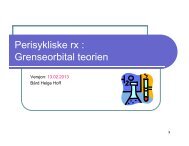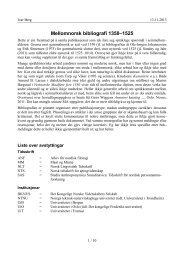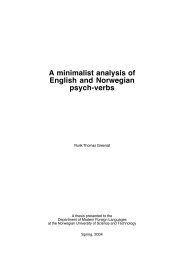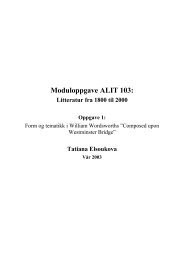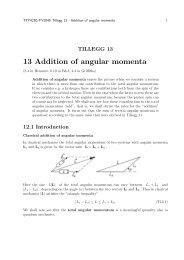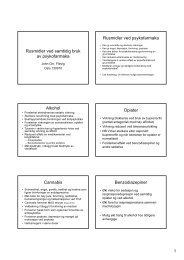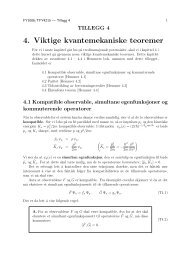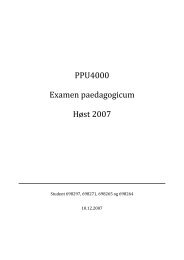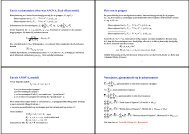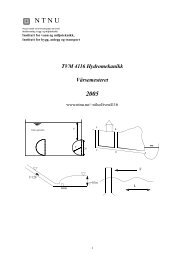Fatigue in thin films Lifetime and damage formation.pdf
Fatigue in thin films Lifetime and damage formation.pdf
Fatigue in thin films Lifetime and damage formation.pdf
You also want an ePaper? Increase the reach of your titles
YUMPU automatically turns print PDFs into web optimized ePapers that Google loves.
920<br />
O. Kraft et al. / Materials Science <strong>and</strong> Eng<strong>in</strong>eer<strong>in</strong>g A319–321 (2001) 919–923<br />
It is the aim of this paper to elucidate the fatigue<br />
mechanisms <strong>in</strong> constra<strong>in</strong>ed volumes <strong>and</strong> to determ<strong>in</strong>e<br />
fatigue lifetimes under these conditions. We present<br />
two methods, which we developed to study the fatigue<br />
behavior of th<strong>in</strong> metal <strong>films</strong> on substrates: The<br />
first technique <strong>in</strong>volves tensile test<strong>in</strong>g of Cu <strong>films</strong> deposited<br />
onto elastic polyimide substrates. Tensile test<strong>in</strong>g<br />
of these specimen results <strong>in</strong> tension–compression<br />
cycles <strong>in</strong> the plastically deformed th<strong>in</strong> film while the<br />
substrate is elastically deformed only. The second<br />
technique utilizes the cyclic deflection of th<strong>in</strong> Ag <strong>films</strong><br />
deposited onto micromach<strong>in</strong>ed SiO 2 cantilever beam<br />
us<strong>in</strong>g a nano<strong>in</strong>dentation system.<br />
2. Experimental<br />
2.1. Tensile test<strong>in</strong>g<br />
For process<strong>in</strong>g of the tensile specimen, shown <strong>in</strong><br />
Fig. 1a, the 125 m thick polyimide substrates (Kapton,<br />
Du Pont) were <strong>in</strong>itially cleaned by r<strong>in</strong>s<strong>in</strong>g with<br />
ethanol <strong>and</strong> pressurized CO 2 . Then, the sample was<br />
mounted <strong>in</strong> the deposition system (base pressure of<br />
5×10 −7 mbar) <strong>and</strong> activated by an oxygen plasma<br />
(O 2 pressure 1×10 −2 mbar, power 100 W, bias<br />
−300 V). Without break<strong>in</strong>g vacuum, 3 m thick Cu<br />
<strong>films</strong> were then sputter deposited at a substrate temperature<br />
of 300°C, a rate of 60 nm per m<strong>in</strong> with an<br />
Ar pressure of 2×10 −3 mbar, a power of 150 W<br />
<strong>and</strong> a bias of −80 V. After deposition, the samples<br />
were annealed <strong>in</strong> a vacuum furnace (6×10 −6 mbar)<br />
at a temperature of 400°C.<br />
The tensile tests were performed <strong>in</strong> an electromechanical<br />
tensile tester (Zwicki 1120, Zwick) under<br />
load control. Samples were cyclically loaded between<br />
a m<strong>in</strong>imum load of 2 N to maximum loads <strong>in</strong> the<br />
range of 15–60 N. Under these conditions, the film is<br />
stra<strong>in</strong>ed with constant total stra<strong>in</strong> ranges between 0.7<br />
<strong>and</strong> 2.1% as determ<strong>in</strong>ed from the crosshead displacement<br />
<strong>and</strong> monitored as a function of the number of<br />
cycles. It is not possible to determ<strong>in</strong>e the film stress<br />
us<strong>in</strong>g this configuration because the externally applied<br />
force is predom<strong>in</strong>antly governed by the mechanical<br />
properties of the substrate. However, microtensile<br />
tests on comparable samples us<strong>in</strong>g an X-ray diffraction<br />
technique enabled the measurements of stress–<br />
stra<strong>in</strong> behavior dur<strong>in</strong>g such experiments as<br />
exemplified <strong>in</strong> Fig. 1b [11]. On load<strong>in</strong>g <strong>and</strong> unload<strong>in</strong>g,<br />
the film is plastically deformed <strong>in</strong> tension <strong>and</strong> <strong>in</strong><br />
compression for a total <strong>and</strong> plastic stra<strong>in</strong> range of 0.5<br />
<strong>and</strong> 0.15%, respectively.<br />
2.2. Microbeam bend<strong>in</strong>g<br />
Fig. 1. Microtensile test<strong>in</strong>g; (a) Sample geometry of the 125 m thick<br />
polyimide foil substrate <strong>and</strong> the Cu film sputtered <strong>in</strong> the middle<br />
section of the dog-bone shaped sample. (b) Typical stress-stra<strong>in</strong><br />
behavior for a Cu film on a polyimide substrate dur<strong>in</strong>g cyclic load<strong>in</strong>g<br />
as measured by X-ray diffraction (second cycle of 0.7 m thick Cu<br />
film, from [11]). The total applied stra<strong>in</strong> range of the cycle is 0.5%,<br />
whereas the plastic stra<strong>in</strong> range amounts only to about 0.15% as<br />
<strong>in</strong>dicated by the arrow with<strong>in</strong> the hysteresis loop.<br />
The microbeam samples are shown schematically <strong>in</strong><br />
Fig. 2a. They consist of a 2.83 m thick SiO 2 layer<br />
<strong>and</strong> a th<strong>in</strong>ner Ag film. The Ag <strong>films</strong>, rang<strong>in</strong>g from<br />
0.2 to 1.5 m <strong>in</strong> thickness, were sputter deposited at<br />
a temperature of about −190°C <strong>and</strong> annealed at +<br />
100°C. A detailed description of film deposition <strong>and</strong><br />
the test<strong>in</strong>g procedure is given <strong>in</strong> [12]. The test<strong>in</strong>g procedure<br />
is briefly described as follows, the beams are<br />
deflected by a commercial nano<strong>in</strong>dentation system<br />
(Nano II, MTS Corp.), which applies a cyclic load<br />
P=P mean +P o cos(2t), where P mean is the mean<br />
load, P o the load amplitude <strong>and</strong> the frequency,<br />
which was chosen to be 45 Hz. In this configuration,<br />
the largest stra<strong>in</strong> occurs at the fixed end of the beam<br />
(as <strong>in</strong>dicated <strong>in</strong> Fig. 2a). Based on elastic beam bend<strong>in</strong>g<br />
theory, this stra<strong>in</strong> can be calculated from the<br />
lever length L <strong>and</strong> the applied load as:<br />
= P(L−x) (z−q) (3)<br />
IE<br />
where I is the moment of <strong>in</strong>ertia, E the Young’s<br />
modulus of the substrate material, q the position of<br />
the neutral axis, <strong>and</strong> x <strong>and</strong> z the coord<strong>in</strong>ates along<br />
the length <strong>and</strong> the thickness of the beam. The mo-



